Have you noticed how much life has sped up over the last decade? There’s hardly any time left for household routines. More and more people are willing to delegate daily tasks like cleaning, shopping, cooking, laundry, and repairs to on-demand services.
Grocery delivery apps have become a huge relief in this race to achieve a better work-life balance. Growing demand, increasing trust in online services, and easy access to the market for startups create the perfect environment for those looking to develop a meal delivery app.
In this article, we’ll cover everything you need to know about grocery delivery app development, including market insights, competitors, business models and development steps, essential features, and technology stacks.
So, if you’re here to learn how to create an app like Instacart or searching for a grocery delivery app development company, this article is for you.
What is a grocery delivery app?
A grocery delivery app is a digital platform that allows customers to browse, order, and pay for groceries online, with the convenience of having them delivered to their doorstep. These apps bridge the gap between physical grocery stores and busy consumers, offering features such as real-time inventory updates, personalized shopping lists, delivery scheduling, and secure payment options. For businesses, grocery delivery apps not only meet the growing demand for online shopping but also create new revenue streams and enhance customer loyalty.
Starting a grocery delivery service requires a well-thought-out strategy and robust technical expertise to ensure a seamless experience for both customers and store operators.
Grocery delivery apps usually work like this:
- The consumer downloads the app to the smartphone or goes to the website.
- The consumer puts items into their virtual shopping cart and provides their billing information and shipping address.
- The platform processes the order and sends it to a shopper (an employee or contractor) who completes the order either by taking the goods from the warehouse or by going and buying items at a local store.
- The completed order is shipped to the customer’s address by a delivery driver or the shopper themselves in their own car.
- The payments are collected, either in cash by the delivery person or online at the moment of the order. The receipt can be emailed or provided in paper with the order to the customer upon the completion of the order.
.png)
Grocery delivery business market overview
The grocery delivery market is experiencing rapid growth as consumers increasingly prioritize convenience and safety in their shopping habits. With advancements in technology and the rise of eCommerce, this industry is transforming how groceries are purchased and delivered globally. But let's get into a more detailed overview.
Market volumes and growth
- The grocery delivery market was valued at $50.28 billion in 2022 and is projected to grow at a CAGR of 26.8%, reaching $1,372 billion in revenue by 2029.
- The number of users is expected to rise to 2.5 billion globally by 2029.
- China is a key market leader, forecasted to generate $266 billion in revenue by 2024, followed by significant contributions from the United States.
.png)
Market structure
The market encompasses several delivery models catering to diverse consumer needs:
- Contactless delivery: Popularized during the pandemic for safety and convenience.
- Same-day delivery: Meets the demand for urgent grocery needs.
- Click-and-collect: Allows customers to order groceries online and pick them up at their convenience.
- Subscription services: Provides recurring deliveries for meal kits or essential groceries.
- Express slots: Offers fast delivery within a specific time frame for added convenience.
Growth drivers
- Changing consumer preferences: Increased demand for convenient, time-saving shopping solutions.
- Technological advancements: Innovations such as:
- Real-time inventory updates to ensure product availability.
- Personalized recommendations to enhance the shopping experience.
- Saved shopping preferences to streamline reordering.
- Rise of eCommerce: The proliferation of online platforms enabling product comparisons and informed purchasing decisions.
- Pandemic influence: Accelerated adoption of online grocery shopping as a safer alternative to in-store shopping.
Challenges
Despite its growth, the market faces notable challenges:
- High operational costs: Managing logistics, labor, and delivery infrastructure can be expensive.
- Delivery efficiency: Ensuring timely and accurate deliveries while minimizing costs remains a significant hurdle.
- Consumer price sensitivity: Balancing delivery fees and product markups with customer expectations is critical.
Opportunities
- Rising disposable incomes: Increasing affordability expands the customer base, particularly in urban areas.
- Innovation potential: Businesses adopting advanced technologies and customer-centric approaches can outperform competitors and capture market share.
- Regional opportunities: While China and the United States lead, emerging markets offer untapped growth potential.
Who are your competitors?
Understanding the top grocery delivery apps is crucial for building a competitive platform. These leaders have set benchmarks in innovation, efficiency, and customer experience, offering valuable lessons for new entrants. Below is a look at some of the most prominent grocery delivery apps in the US according to Statista:

- Instacart: Groceries & Food Founded in 2012, Instacart partners with local and national retailers to offer same-day delivery and pickup of groceries and household items. The app specializes in personalized shopping experiences, allowing users to order from multiple stores in one session.
- 7-Eleven: Rewards & Shopping This app, launched by 7-Eleven, focuses on loyalty rewards and in-store convenience shopping. Customers can earn points on purchases, order snacks and essentials for delivery or pickup, and find exclusive deals.
- Gopuff - Food & Drink Delivery: Gopuff, founded in 2013, specializes in ultra-fast delivery of convenience items, including snacks, drinks, household essentials, and over-the-counter medication, often within 30 minutes.
- Bobby Approved - Food Scanner: Perfect for health-conscious shoppers, Bobby Approved simplifies grocery shopping by ensuring users select only the best for their dietary needs.
- Sprouts Farmers Market: Sprouts' app offers online ordering, delivery, and pickup services, focusing on natural and organic groceries. Founded in 2002, it provides exclusive digital coupons and weekly deals.
- Jewel-Osco Deals & Delivery: Jewel-Osco, a well-established grocery chain, provides an app for delivery and curbside pickup. It emphasizes savings with digital coupons, loyalty rewards, and personalized offers.
- Publix Delivery & Curbside: Founded in 1930, Publix offers delivery and curbside pickup through its app, specializing in fresh groceries, deli items, and bakery goods. The app integrates with Instacart for delivery services.
- Stop & Shop: This regional grocery chain's app enables users to order groceries for delivery or pickup. It also offers a rewards program, personalized deals, and a loyalty card for savings.
- Weee! #1 Asian Grocery App: Founded in 2015, Weee! specializes in delivering Asian and international groceries. It offers hard-to-find ingredients, fresh produce, and ready-made meals, catering to diverse culinary needs.
- 7NOW: Food & Alcohol Delivery: A delivery service from 7-Eleven, this app focuses on delivering snacks, beverages, and alcohol. It offers 24/7 convenience with speedy delivery times in select areas.
Just look at the number of downloads! These apps must be doing pretty well. But how can you get even better results?
How to stand out among the competition when starting a grocery delivery company?
The main challenge for entering a grocery delivery business is tough competition. You will have to pave your way through the worldwide known leaders and those who have already set the market.
So, the reasonable question is how to build an app like Instacart but not become another clone. The possible solutions for standing out are:
.png)
1. Provide better services
To build an app like Postmates, Instacart, or alike, you should not blindly copy them, but try to find a unique value that your app will give you customers. Focus on solving common pain points that customers face. High delivery fees, marked-up prices, and poor-quality item selection are frequent complaints. Offering competitive pricing, transparent fees, and strict quality control for perishables can immediately set your service apart.
Enhance convenience with a fast, intuitive app or website. Simplify the shopping experience by providing clear product descriptions, faster load times, and options for detailed substitution preferences. Avoid clutter like irrelevant sponsored items and ensure a seamless checkout process.
To attract new customers, offer incentives such as free delivery for the first order or loyalty discounts for repeat users. By addressing these areas and consistently delivering value, you can create a service that outshines competitors and builds lasting customer loyalty.
2. Add unique features
As Jat Sahi, from Fujitsu, put it “If you can’t differentiate, you’ll never make much margin or profit.”
Research the market and trends and find how new technologies can make the grocery online shopping experience easier and more fun.
For example, Swift has a ‘buy again’ feature that allows customers to save time ordering the items that they need on a constant base.
Or you can provide the shopping lists of products for definite recipes. Or suggesting products that go on discount.
Pay attention to the trends. For example, since it became popular to order meal kits, Blue Apron became one of the leaders in this niche with constantly growing revenue.
3. Explore new areas
Starting a delivery business in areas that remain underserved or untapped by existing players can be a promising opportunity. Regions like Myanmar, Vietnam, and the Philippines are emerging as prospective markets for online grocery delivery, with the transaction volume for food delivery in South Asia projected to reach $28 billion by 2025.
Entering an untapped market offers advantages such as reduced competition, more flexibility in setting prices, and the ability to grow your service at a manageable pace. However, being a pioneer in these regions comes with challenges, such as building awareness and creating demand for delivery services in markets where the concept is still developing. A well-planned strategy focused on educating potential customers and gradually scaling operations can help overcome these initial hurdles.
4. Set a narrow niche of products
Focusing on a specific product niche can set your grocery delivery app apart and attract loyal customers. Specialization allows you to build a strong brand while targeting unique customer needs. For example, Good Eggs excels by offering organic, sustainably sourced groceries, appealing to health-conscious consumers.
Here are some niche ideas:
- Milk delivery: Fresh milk and breakfast essentials daily, inspired by apps like MilkBasket and BBdaily.
- Liquor delivery: Alcohol delivery apps like Drizly and Saucey cater to party-goers and casual drinkers.
- Meat and fish delivery: Fresh protein delivery from apps like ButcherBox and CrowdCow.
5. Focus on personalization
Personalization can help your grocery delivery app stand out by tailoring the shopping experience to individual customer preferences. Use AI to recommend products based on purchase history, dietary preferences, or frequently bought items, similar to how Instacart suggests items customers might have forgotten to add. Apps like Weee! take it a step further by curating product recommendations for niche audiences, such as those looking for Asian groceries.
Offer features like saved shopping lists, personalized discounts, and product alerts to keep customers engaged and coming back. A tailored experience creates loyalty and sets your app apart from generic competitors.
While each niche has unique operational needs, the core app functionality—like product selection and order tracking—remains the same, making it easier to build a specialized, standout platform.
Custom grocery delivery application development
Contact UsHow to build a grocery delivery business website
Building a grocery delivery website requires a structured approach to ensure it meets customer needs and performs efficiently. Here’s a detailed guide for each step:
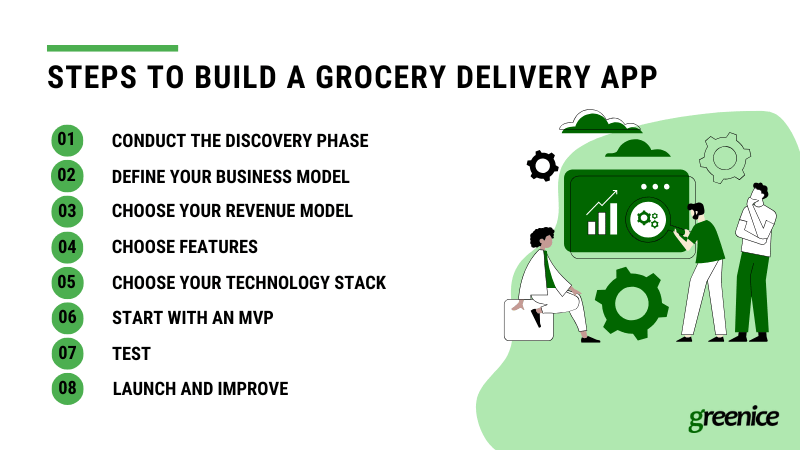
Conduct a discovery phase
The discovery phase is the foundation for building a successful grocery delivery website. During this stage, the development team collaborates closely with stakeholders to align technical and business goals.
The process begins with identifying the target market by defining the customer demographics, shopping habits, pain points, and preferences. This helps shape the user experience and ensure the platform meets customer expectations. Next, the team conducts a thorough competitor analysis to study existing grocery delivery platforms. By examining their strengths, weaknesses, and unique features, opportunities for differentiation and improvement are identified.
Once the market research is complete, the team drafts detailed user journeys, mapping out how users will interact with the platform from registration to checkout and delivery. This ensures a smooth, intuitive experience for customers, shoppers, and administrators.
The discovery phase culminates in the creation of a Software Requirements Specification (SRS) document, which acts as the project’s blueprint. The SRS outlines all functional requirements, design specifications, third-party integrations (e.g., payment systems, POS), and scalability needs. This document ensures that all team members—from developers to designers—are aligned throughout the project lifecycle, minimizing scope creep and delivering a clear development roadmap.
Define your business model
Choosing the right business model is critical for the success of a grocery delivery website, as it determines how the platform will operate and cater to its users. The development team will help analyze your goals, technical needs, and market requirements to shape the platform accordingly.
- Single-store or chain app: If you are a single grocery store or a retail chain, the focus will be on integrating your platform with internal inventory systems like POS (Point of Sale) or ERP (Enterprise Resource Planning) software. This ensures real-time product updates, pricing synchronization, and seamless order fulfillment across physical and digital channels.
- Aggregator grocery delivery app: For marketplace-style platforms that connect multiple stores, the team designs a scalable and modular architecture. Integration with third-party APIs allows onboarding of numerous vendors, price comparisons, and dynamic product availability across locations. Features such as vendor dashboards and analytics help stores manage orders effectively.
- Meal-kit delivery app: If your focus is on delivering pre-portioned ingredients and recipes, the team develops custom features such as recipe catalogs, inventory tracking for fresh ingredients, and advanced scheduling systems to ensure timely and quality deliveries. Meal-kit delivery apps often require streamlined logistics for perishable items to ensure freshness.
Choose your revenue model
Selecting the right revenue model is key to building a successful grocery delivery platform. Here are the most common models:

- Subscription model: Ideal for frequent users, this model offers unlimited deliveries and perks for a fixed fee. For example, Instacart+ charges $99/year or $14.99/month for free delivery on orders over $35, plus benefits like reduced peak-hour fees.
- Commission and delivery fees: For occasional users, platforms charge commissions (e.g., 5% service fee) and flat delivery fees, such as Instacart’s $3.99–$7.99 per order, excluding tips.
- Product markup: Platforms increase item prices to cover costs. Instacart applies up to a 15% markup for non-partner stores, ensuring profitability without upfront charges for users.
- Advertisements: Revenue comes from sponsored content, priority listings, or banners. Offering an ad-free premium option, as some platforms do, caters to users seeking a cleaner experience.
Additional earnings come from sales taxes and delivery tips, benefiting both the platform and gig workers.
The development team works closely with stakeholders to integrate the chosen monetization methods seamlessly into the platform. By aligning the model with technical solutions, your platform will not only attract customers but also generate consistent revenue from multiple streams.
Choose features of your delivery app
It does not make a big difference in features whether you are searching for guidance on a general grocery, liquor, or milk delivery app development. Any on-demand grocery app should enable customers to find the necessary goods, add them to the online cart, pay, and schedule delivery. The system should process the order and assign an available shopper. who makes the purchase and delivers the goods in exchange for a fee.
Now let’s describe all features in detail.
Core features
To start your own grocery delivery business app or website, choose the most important features that will make the skeleton of the platform.
To create a grocery delivery app, you will need the following core features:
1. Product search and categorization
Users should be able to search for products either by category or by entering a keyword in the search bar.

2. User profile
This is where the user can add her address and billing information, and also set preferences for future purchases. The user should also be able to view order history, coupons, loyalty discounts, and gift cards.
3. Payments
Provide customers with as many payment options as possible. Cash, cards, wallets, bonuses, gift cards, and coupons. As the order is submitted, email the invoice to the customer and add the order record to the History of Orders.
4. Checkout
The checkout process may include several steps:
- Viewing and editing the items and their quantity
- Applying member cards, coupons, and discounts
- Setting tips for the delivery person
- Filling customer contact details (to facilitate the process, insert the address from the user profile but make it editable).
- Choosing a delivery date & time.
- Adding delivery instructions.
- Adding payment details.
- Confirming the order.
5. Product recommendations
63% of smartphone users buy from apps or sites that suggest relevant products or services that users may be interested in buying.
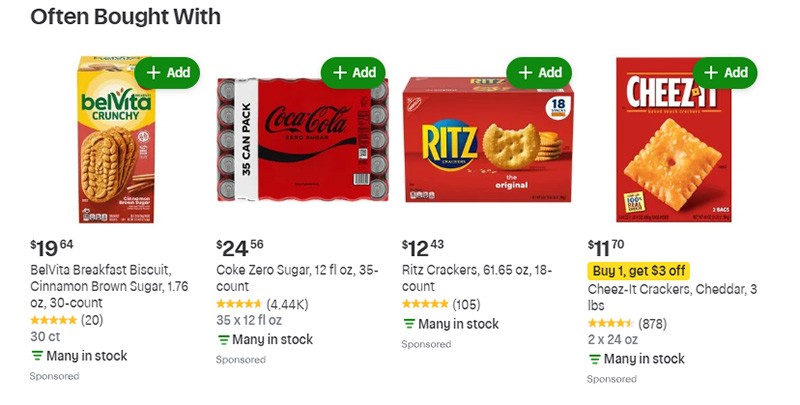
The best examples of product recommendations are ‘Featured items,’ ‘Daily deals,’ ‘This goes well together,’ ‘Previously purchased,’ ‘Often bought with,’ as well as recipes with ready sets of ingredients, and freshness ratings. These, and also the history of previously bought products, can increase your average order. Using AI, you can analyze similar users’ purchases and make more accurate suggestions.
Instead of spending hours searching for a product, users can follow your suggestions and make the order in minutes.
6. Admin section
The admin section is the backbone of a grocery delivery platform, providing the tools needed to manage operations efficiently. This back-office system enables the admin team to:
- Handle user accounts, resolve complaints, and monitor user activity.
- Approve new shoppers, track performance, and handle payouts.
- Monitor the status of all orders, resolve issues, and handle cancellations.
- Configure delivery fees, service charges, and manage subscription plans.
- Organize the product catalog and update inventory details.
- Enable promotional offers and coupon codes.
- Push alerts for order updates, discounts, or policy changes.
- Update blogs, banners, and ads to keep the platform engaging.
- Manage vendor agreements, commissions, and track partner performance.
- Create detailed analytics on sales, customer behavior, and operational efficiency.
The backend architecture of the admin section differs based on the chosen business model:
- Single-store app: Focuses on direct inventory integration with the store’s POS system for real-time updates and simplified order tracking.
- Aggregator app: Requires multi-vendor management, complex order routing, and tools to handle partner-specific commissions and inventory synchronization.
- Meal-kit delivery app: Includes recipe management, scheduling tools for recurring deliveries, and systems to manage perishable stock efficiently.
7. Shopper section
The shopper section is a vital component of grocery delivery platforms like Instacart and Shipt, enabling independent shoppers to manage their work effectively. After meeting eligibility requirements and completing the onboarding process, approved shoppers gain access to this section through the platform's website or mobile app.
Within the shopper section, users can:
- Update personal information, add payment details, and complete training modules if required.
- Indicate their working hours and days to ensure they receive orders that match their schedule.
- Browse and select delivery tasks based on proximity, earnings potential, and item lists.
- Monitor payment details, including tips, and review their total income over time.
- Use integrated messaging tools to clarify substitutions or provide updates on delivery status.
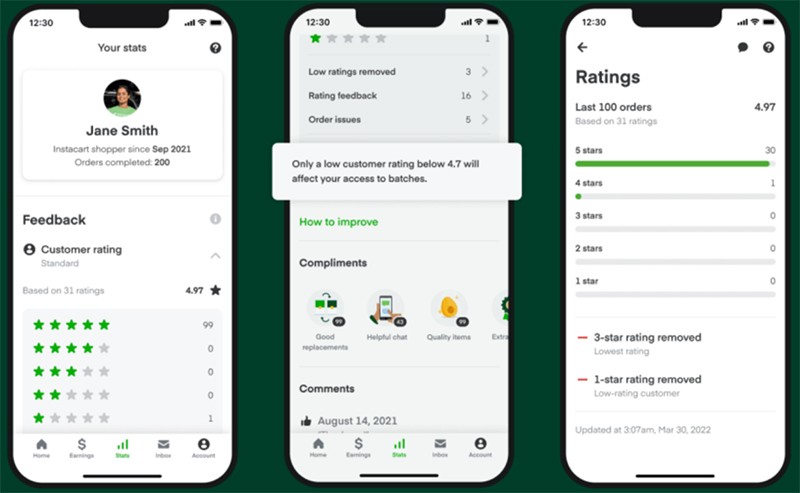
Unique features
To stand out in the competitive world, you need to give your customers the added value that can be created with unique features. Here are some examples:
1. Shared shopping lists
Remember how tiresome the creation of shopping lists can be when several family members live under one roof? Make it easy to share product lists and order everything in one place without the risk of missing or duplicating something. That is why Instacart and some other apps have a ‘Shop with Friends’ feature. Thus, consumers can easily view each other’s lists of products and how much they cost. Look at the picture below to see how it works:
2. Tracking the order delivery
Waiting for the order, people feel obligated to stay home and NOT do other things for fear of missing the delivery. Having a GPS-tracker like Amazon Fresh allows them to relax and go about their day without worries.
3. Buying ingredients for recipes and meal plans
When people buy groceries, they usually already have an idea of the dishes they are going to cook. Why not save time and effort?
Create an API that will integrate your app with popular recipe websites. Users fill the cart with all necessary ingredients in the correct proportion with a single click of a button.
Instacart partnered with Yummly and AllRecipes, the Internet’s largest cooking portal. Integration with famous recipe portals is a great idea for your service to let their customers make instant orders, but be ready to compete with similar apps.
4. Dynamic pricing
The delivery fee typically depends on the size of the order, delivery time, urgency, and location. However, you can also consider adjusting your fees at peak demand times. In this case, during the busiest shopping hours, the fee may change and the users should be notified of the price change. This is just like Uber’s dynamic pricing that some hate, while others adore.
5. Cashback and coupons
People love discounts and cashback, so you can integrate your platform with services that process coupons, cashback, and other perks.
6. AI features
AI can improve grocery delivery apps by enhancing operations and customer satisfaction.
- Personalized recommendations: AI analyzes customer behavior to suggest products tailored to their preferences. Amazon Fresh leverages this by recommending items based on past purchases, increasing customer engagement.
- Route optimization: AI algorithms calculate the fastest delivery routes, factoring in real-time traffic and weather. Instacart employs this to ensure timely deliveries while reducing fuel costs for drivers.
- Improved search: Natural Language Processing (NLP) enhances search functionality. For example, Instacart's AI-powered "Ask Instacart" tool enhances grocery shopping by answering customer questions, providing personalized recommendations, and streamlining decision-making for a more efficient and tailored shopping experience.

By integrating AI features like these, grocery delivery apps can streamline processes, offer personalized experiences, and stand out in a competitive market.
Choose your technology stack
Selecting the right technology stack is a pivotal step in building a high-performing and scalable grocery delivery platform. The development team evaluates your project goals, budget, and timelines to recommend the best solutions.
| Category | Technology |
| Back-end | Laravel (PHP), Node.js |
| Hosting/Cloud | AWS, Google Cloud |
| Database | PostgreSQL, MongoDB |
| Front-end (for web version) | React.js, Vue.js |
| Native | Objective-C (iOS), Java (Android) |
| Cross-platform | Flutter, React Native |
On the backend, robust frameworks like Laravel (PHP) and Node.js ensure fast and secure data processing, user authentication, and integration with third-party systems (e.g., payment gateways and inventory management tools).
For hosting and scalability, cloud services like AWS or Google Cloud provide flexible infrastructure, while databases such as PostgreSQL and MongoDB efficiently manage product catalogs, orders, and user data as the platform grows.
To create interactive and dynamic user interfaces for the web version of grocery delivery platforms use frameworks like Vue.js and React.js. React.js is widely favored for its component-based architecture, while Vue.js is known for its simplicity and flexibility, making them excellent choices for scalable and maintainable front-end development.
As for the front-end native technologies like Objective-C (iOS) and Java (Android) offer superior performance and access to device-specific features, they require separate development efforts for each platform. This can significantly increase time and costs, making them less practical for startups or businesses looking for quick go-to-market solutions.
For most grocery delivery platforms, cross-platform technologies like Flutter or React Native are ideal. These frameworks allow developers to write a single codebase that runs seamlessly on both iOS and Android. This approach saves time, reduces costs, and accelerates the development process while delivering performance close to native applications.
Start with an MVP
When starting your grocery delivery platform, consider beginning with a Minimum Viable Product (MVP). An MVP, which includes essential features like user registration, product search, a shopping cart, payment processing, and order tracking, is a common practice that allows you to launch quickly with minimal investment.
The MVP allows you to gather valuable feedback from early users, helping identify pain points and feature requests. The development team uses this data to prioritize improvements and plan future iterations. Starting with an MVP not only reduces risk but also gives you a competitive edge by getting your platform to market faster.
However, if your vision and budget allow, creating a full-featured platform from the start is also a viable option, offering a complete experience to your customers right away. The choice depends entirely on your goals and strategy.
Test
Testing is a critical step to ensure the grocery delivery platform is reliable, secure, and user-friendly. The development team performs thorough, multi-stage testing to identify and fix any issues:
- Functional testing: Ensures that every feature—such as search, payments, and order tracking—works as intended, providing a seamless experience for customers.
- Usability testing: Verifies that the platform is intuitive and easy to navigate, ensuring users can complete tasks effortlessly.
- Performance testing: Measures the website’s speed, load times, and server response under high traffic to ensure stability during peak usage.
- Security testing: Protects user data, payment information, and other sensitive details. The team ensures compliance with global standards such as GDPR (General Data Protection Regulation) and PCI-DSS (Payment Card Industry Data Security Standard).
By addressing these aspects during the testing phase, the platform is optimized for performance, security, and usability.
Launch and improve
After extensive testing, the platform is ready to launch. The development team deploys the website on hosting services or app stores, ensuring a smooth transition to the live environment. Post-launch, the team monitors the platform’s performance in real-time using analytics tools. These tools track user behavior, order metrics, and system performance, providing valuable insights into platform usage.
Continuous improvement is key to staying competitive. By collecting user feedback and analyzing data, the development team identifies areas for optimization, resolves issues, and rolls out new features. Regular updates keep the platform fresh, responsive to market demands, and aligned with customer expectations.
With ongoing monitoring and enhancements, your grocery delivery platform evolves into a robust, user-friendly solution that drives customer satisfaction and business growth.
By following these steps, your development team ensures the grocery delivery website is built to be functional, scalable, and aligned with your business goals. This structured approach provides a strong foundation for success in the competitive grocery delivery market.
Costs to develop a grocery delivery website
The development costs for a grocery delivery website can vary widely depending on the selected development methodology. Let’s explore two possible options: white-label solutions and custom development and how to choose between them.
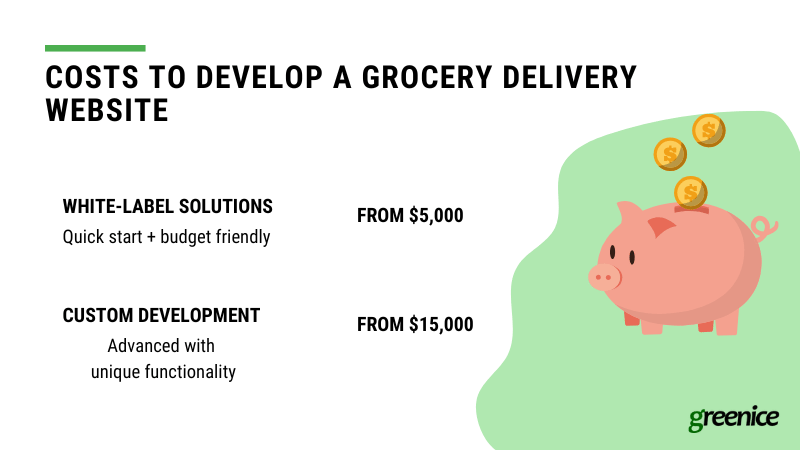
Quick start + budget friendly
With white-label solutions, startups can launch an MVP for as little as $5,000 to $15,000. The cost varies depending on the degree of customization and the features required. For example, integrating advanced functionalities like AI-driven recommendations or real-time delivery tracking may increase the cost but provide significant value.
This pricing option is ideal for startups that want to test the market, attract initial users, and refine their offering without heavy upfront investment. It provides a solid foundation to build upon as the business grows.
For single-store or meal-kit startups looking to enter the grocery delivery market quickly and affordably, white-label solutions are an excellent choice. These solutions leverage pre-built codebase that can be customized to fit your business needs while allowing for the necessary features like:
- User registration and login
- Product catalog
- Search and filters
- Shopping cart
- Checkout and payment
- Order tracking
- Admin panel
- Push notifications
Advanced with unique functionality
Custom development is ideal for businesses seeking a unique, fully tailored platform. Built from scratch, this approach provides complete control over design, features, and scalability. Starting at $15,000 for an MVP at Greenice, costs can increase based on complexity, feature requirements, and developer rates.
This option is best suited for:
- Unique business models: Apps introducing new delivery concepts or workflows.
- Advanced features: AI-driven personalization, dynamic pricing, or multi-vendor management.
- Scalability: Large-scale operations with high user and transaction volumes.
- Special integrations: Proprietary tools or advanced analytics.
Custom development ensures a solution perfectly aligned with your business vision, offering scalability, differentiation, and a premium user experience. Though it requires a higher initial investment, it’s ideal for businesses aiming for long-term growth and innovation.
How to apply this to your business
Grocery delivery apps are booming, and there’s never been a better time to jump in. In this article, we’ve covered the essentials of grocery delivery app development, from market trends and business models to the core features, tech stacks, and even advanced options like AI integration.
If you’re just starting out, you don’t need to overcomplicate things. Focus on the basics—like user registration, a product catalog, and easy order tracking. Once your business takes off, you can always add more advanced features to make your app even better.
At Greenice, we’ve worked on over 200 projects, so we get how challenging it can be to start something new. We’re here to help you bring your vision to life, whether it’s a simple MVP or a fully-featured app that can compete with the big names like Instacart. Let’s build something great together!
Looking for a grocery app development company?
Contact UsRate this article!
5




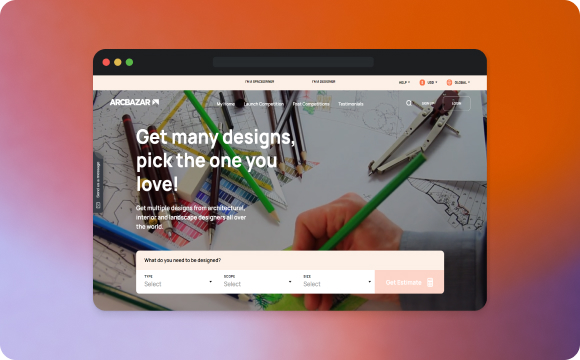
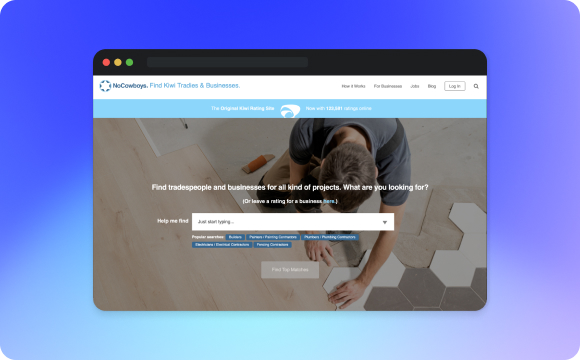



 Sign in with Google
Sign in with Google
Comments (0)